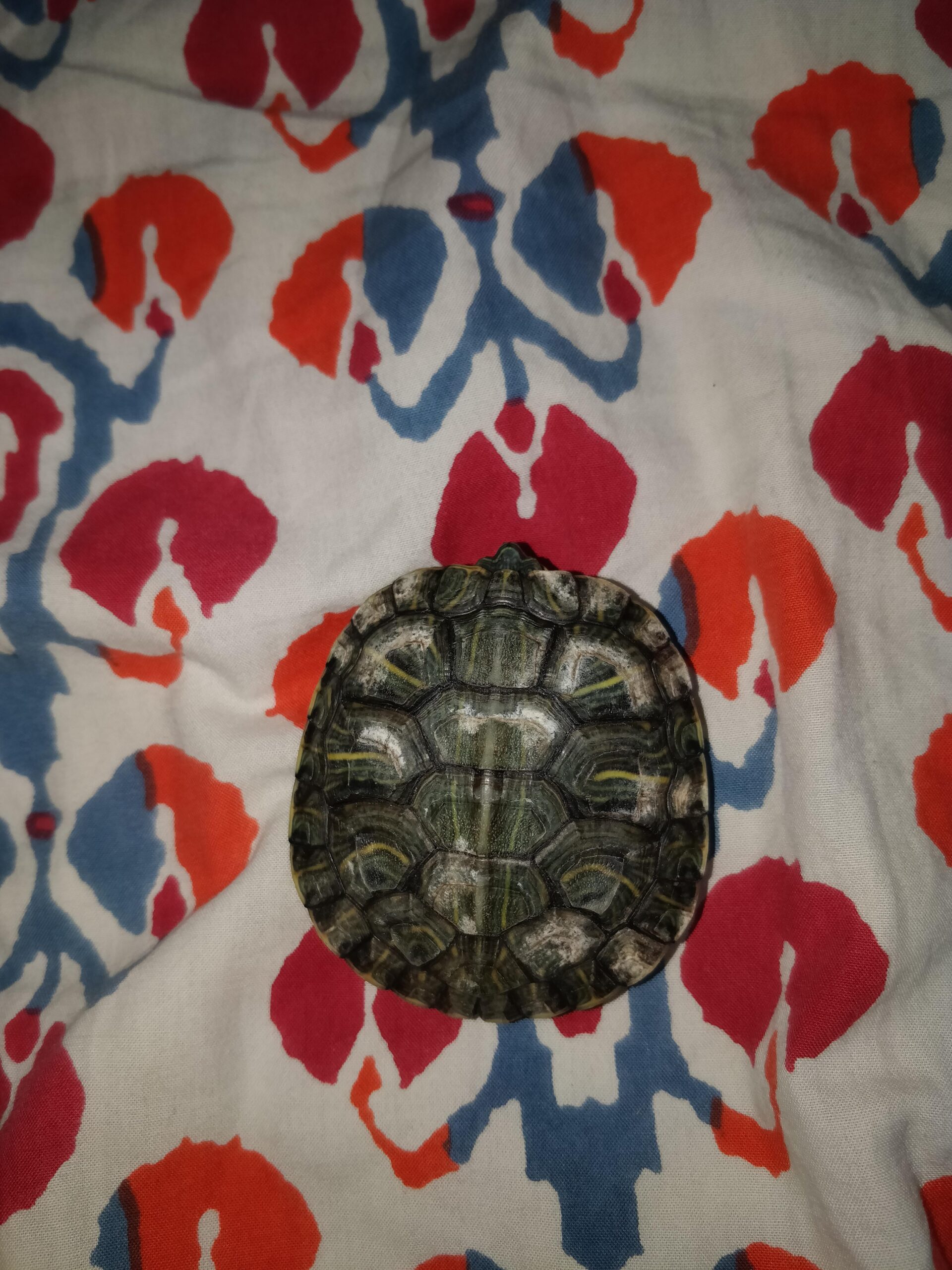A turtle’s shell turning white may indicate a fungal infection or a lack of proper nutrition. This condition should be addressed promptly by a veterinarian to prevent further complications.
Seeing your beloved pet’s shell change color can be alarming. While it may simply be shedding or a natural aging process, it could also signal an underlying health issue. By understanding the possible reasons behind your turtle’s shell turning white, you can take the necessary steps to ensure its well-being.
We will explore the common causes of this phenomenon and provide guidance on how to properly care for your turtle’s shell. Let’s delve into the reasons behind why your turtle’s shell may be changing color and how to address it effectively.
Common Causes Of White Turtle Shells
When you notice your turtle’s shell turning white, it can be concerning. Understanding the common causes of white turtle shells can help you identify and address the issue promptly.
Nutritional Deficiencies
A lack of essential nutrients like calcium can lead to the whitening of your turtle’s shell. Ensure your pet is receiving a balanced diet with proper vitamins and minerals to maintain a healthy shell.
Fungal Infections
Fungal infections can cause white patches or spots on your turtle’s shell. Proper hygiene and keeping the habitat clean can help prevent fungal growth and maintain shell health.
Shell Rot
Shell rot is a common issue that can cause discoloration and deterioration of the shell. Regular cleaning and proper humidity levels in the enclosure can help prevent shell rot in turtles.
Symptoms To Look Out For
Turtles are known for their distinctive shells, which serve as a protective armor for these fascinating creatures. However, if you notice that your turtle’s shell is turning white, it could be a cause for concern. Understanding the symptoms to look out for can help you identify potential issues and take appropriate action to ensure your turtle’s health and well-being.
Changes In Shell Color
One of the most apparent symptoms to watch out for is changes in the color of your turtle’s shell. A healthy shell should have a consistent and vibrant coloration. If you observe any noticeable whitening or discoloration, it may indicate an underlying health issue that requires attention.
Peeling Or Flaking Shell
Another concerning symptom is the presence of peeling or flaking on the shell. A turtle’s shell should be smooth and intact. Any signs of flaking or peeling could indicate a potential shell infection or nutritional deficiency that needs to be addressed promptly.
Abnormal Shell Texture
Abnormal shell texture is another crucial indicator to be mindful of. A healthy turtle shell should feel smooth and firm to the touch. If you notice any irregularities in texture, such as soft spots or rough areas, it could be a sign of an underlying health issue that necessitates attention.
Preventive Measures
If you have a pet turtle, you may have noticed that its shell is turning white. This can be a sign of a serious health issue that requires immediate attention. In this blog post, we will discuss the preventive measures that you can take to ensure your turtle’s shell remains healthy and strong.
Balanced Diet
A balanced diet is essential for maintaining your turtle’s shell health. A turtle’s diet should include a variety of foods such as vegetables, fruits, and protein sources. Make sure that you are feeding your turtle a diet that is appropriate for its species and age. You can consult with your veterinarian or do some research to determine the appropriate diet for your turtle.
Proper Habitat Maintenance
Proper habitat maintenance is crucial for keeping your turtle healthy. Make sure that your turtle’s enclosure is clean, and the water is changed regularly. Turtles are susceptible to bacterial and fungal infections that can cause their shells to turn white. Therefore, it is important to keep the enclosure clean and dry to prevent these infections.
Regular Vet Check-ups
Regular vet check-ups are important for ensuring your turtle’s overall health, including the health of its shell. A veterinarian can examine your turtle’s shell and identify any issues before they become serious problems. They can also provide you with advice on how to maintain your turtle’s shell health.
By following these preventive measures, you can ensure that your turtle’s shell remains healthy and strong. Remember that prevention is always better than cure, so take the necessary steps to keep your turtle healthy.
Credit: www.quora.com
Treatment Options
Treatment options for a turtle with a white shell may vary depending on the underlying cause. It is crucial to consult a veterinarian to determine the specific treatment plan for your turtle. Here are some common treatment options that may be recommended:
Vitamin Supplements
Vitamin supplements can help improve the overall health and condition of a turtle’s shell. Calcium and Vitamin D3 are essential for shell health, and a deficiency in these nutrients can lead to shell abnormalities. Your veterinarian may recommend specific calcium and vitamin D3 supplements to be added to your turtle’s diet to address any deficiencies.
Antifungal Medications
If the white discoloration on your turtle’s shell is caused by a fungal infection, your veterinarian may prescribe antifungal medications. These medications can help to eliminate the fungal infection and prevent it from spreading further. It is important to follow the prescribed dosage and treatment duration to effectively address the fungal issue.
Topical Treatments
In some cases, topical treatments such as antifungal creams or ointments may be recommended to directly address localized fungal infections on the turtle’s shell. These topical treatments are applied directly to the affected areas and can help to alleviate the fungal infection while promoting healing of the shell.
Consulting A Veterinarian
Consulting a veterinarian is crucial when dealing with any health concerns regarding your turtle, including issues related to its shell turning white. A veterinarian specializing in reptiles will have the expertise and knowledge to accurately diagnose the underlying cause of the shell discoloration and provide the most effective treatment plan.
Importance Of Professional Diagnosis
Obtaining a professional diagnosis from a veterinarian is essential as it ensures that the exact cause of the shell turning white is identified. Misdiagnosing the issue can lead to ineffective treatment and potential worsening of the condition. A veterinarian will conduct thorough examinations and diagnostic tests to determine whether the white shell is caused by a fungal infection, nutritional deficiencies, or other health issues.
Customized Treatment Plans
Once the veterinarian has identified the root cause of the shell discoloration, they can develop a customized treatment plan tailored to your turtle’s specific needs. This may include medication, dietary adjustments, environmental changes, or other targeted interventions to address the underlying health issue and restore the shell’s natural color and integrity.

Credit: m.youtube.com
Case Studies
Discover real-life case studies investigating why turtles’ shells turn white. Uncover insights on potential causes and solutions for this concerning issue. Gain valuable knowledge to help care for your pet turtle’s health.
Many turtle owners face the problem of their turtle’s shell turning white. This can happen due to various reasons, including improper diet, lack of sunlight, and fungal infections. Let’s take a look at some case studies to understand the challenges faced and the recovery stories of turtles whose shells turned white.Recovery Stories
Case 1: Rocky, a 5-year-old red-eared slider, had a white shell due to a lack of calcium and sunlight. His owner consulted a veterinarian who recommended a calcium-rich diet and exposure to sunlight for a few hours every day. Within a month, Rocky’s shell started regaining its natural color. Case 2: Speedy, a 3-year-old painted turtle, had a fungal infection that caused white patches on his shell. His owner treated him with antifungal medication and kept his tank clean and dry. After a few weeks, Speedy’s shell started looking healthier.Challenges Faced
Case 1: Daisy, a 7-year-old box turtle, had a white shell due to a fungal infection. Her owner tried treating her with over-the-counter antifungal medication, but it did not work. The owner then consulted a veterinarian who prescribed a stronger medication, but Daisy did not respond well to it. The owner had to take Daisy to the veterinarian multiple times before the infection was completely cured. Case 2: Bubbles, a 4-year-old map turtle, had a white shell due to a lack of calcium in his diet. His owner started giving him calcium supplements, but Bubbles did not like the taste and refused to eat them. The owner had to experiment with different types of calcium supplements before finding one that Bubbles liked. In conclusion, the white shell is a common problem faced by turtle owners, but it can be cured with proper care and treatment. It is essential to consult a veterinarian if the problem persists despite trying home remedies.Educational Outreach
As part of our educational outreach, we aim to raise awareness about the health and well-being of turtles, particularly focusing on the issue of a turtle’s shell turning white. It’s essential for turtle owners to understand the causes and potential solutions for this concerning issue. By sharing knowledge and providing guidance, we can ensure the welfare of these remarkable creatures.
Raising Awareness
Turtle enthusiasts must be aware of the potential reasons behind a turtle’s shell turning white. By understanding the causes, they can take proactive measures to prevent and address this condition, ultimately promoting the overall health of their beloved pets.
Sharing Knowledge With Turtle Owners
Empowering turtle owners with the necessary information is crucial. Whether it’s through online resources, community workshops, or social media platforms, we strive to share insights and practical advice to help turtle owners recognize, address, and prevent the phenomenon of white shells in turtles.

Credit: www.reddit.com
Conclusion
In essence, a white turtle shell can indicate a health issue, such as a lack of calcium or a fungal infection. It’s crucial to provide your turtle with a balanced diet, proper lighting, and a clean environment. Regular check-ups with a veterinarian can help maintain your turtle’s well-being and prevent shell discoloration.
Understanding the causes and taking preventive measures will ensure your turtle’s shell remains healthy and vibrant.






Leave a Reply